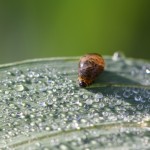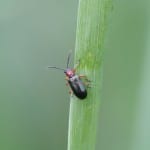Just some food for thought on insect management as we progress with planting during the next several weeks.
1) Cutworm Control: Although not a common problem, a few fields get whacked by cutworms every year. There are really two approaches to preventing problems with cutworms. One is pre-plant vegetation management. A field kept relatively free of weedy vegetation for 2-3 weeks prior to planting is unlikely to have a significant population of cutworms, especially large larvae that can do damage quickly. And any hatching or small larvae present as the crop emerges will often be suppressed by the Bt technologies commonly used in corn and cotton. Pre-plant vegetation management also helps prevent problems with other pests that may be feeding on weeds. The second approach is the near-planting application of insecticide. This application should be made within one week before or after planting and is not a bad idea of your burndown application was late, not giving a 2-3 week weed free window before planting. Pyrethroid insecticides at relatively low rates are typically the product of choice. In either case, it is wise to scout fields during the seedling stage in case cutworms are causing more stand loss than can be tolerated. Recommended insecticides and rates are listed in the 2014 Insect Control Recommendations for Field Crops.
2) Thrips Control and Insecticide Seed Treatments in Cotton: I addressed some of the issues with performance problems with insecticide seed treatments in a previous article (Thinking Ahead – Thrips Management in Cotton). This article provided suggestions on management options, but a take home point is that a preventative, at-planting treatment is still recommended for thrips control.
3) Insecticide Seed Treatments in Soybean: Long term data suggests these treatments provide about a two bushel yield bump in soybean. We are talking about imidacloprid (e.g., Gaucho), thiamethoxam (Cruiser), and clothianidin (NipsIt). Frankly, my data for the last several years has not shown much response. Nevertheless, I encourage growers to use an insecticide seed treatment on at least part of their soybean crop. I would be especially inclined to use these treatments on early planted soybean or fields with a lot of weedy vegetation present at planting. It is a no brainer to use an insecticide seed treatment if a fields is being put into production after being left fallow or in a CRP program the previous year(s).
4) Insect Pests in Wheat: The phone has been pretty quiet on this front. However, fields should be monitored weekly until at least the dough stage. The primary insects of concern at this stage of the game are cereal leaf beetles (pictured below) or true armyworms. These pests need to be managed to prevent excessive defoliation, especially during the milk stage (or before). For true armyworm infestations that occur during the spring, use a threshold of 6-8 larvae per square foot if wheat is still in the milk stage. Once past the milk stage, wheat can tolerate higher populations and treatment is not usually recommended unless larvae are cutting wheat heads. For cereal leaf beetles, check 10 plants per sample site (4 -6 sites per field) for larvae and adults. Treatment is suggested if 25 or more larvae are present per 100 tillers and wheat is still in the milk stage. If you’re unfamiliar with this insect, it is the larvae that usually cause most of the injury by scouring the surface of leaves. The larvae cover themselves with ‘goo’. It is easy to know when many are present because your pants get stained as you walk through the field. Pyrethroid insecticides are the products most commonly used to control either pest.



